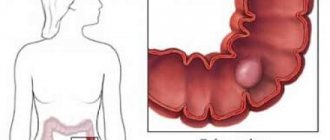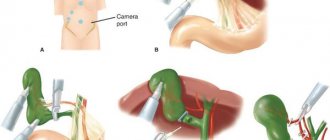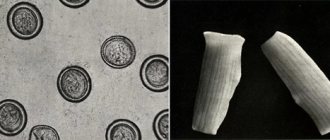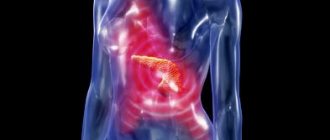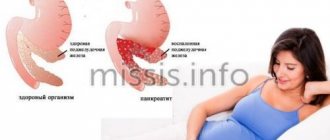What, besides the heart, can hurt “in the area of the heart”?
First, we need to understand the various causes of chest pain and additional symptoms of possible diseases.
1. Pathologies of the respiratory system
. Chest pain, including in the heart area, can be a consequence of lung diseases - pleurisy, pneumonia, pneumothorax. It is worth paying attention to the accompanying symptoms - cough, chest tightness, difficulty breathing, increased body temperature.
2. Gastrointestinal pathologies
. Oddly enough, pain in the stomach, spleen and pancreas can feel like pain in the heart. Pay attention to symptoms such as: bloating, digestive problems, belching, nausea, heaviness in the abdomen, hunger pains, pain in response to eating fatty foods.
3. Neuralgia
- damage to peripheral nerves - often disguised as heart disease. Often accompanied by changes in skin sensitivity, muscle trembling, redness and itching of the skin, pain during inspiration.
4. Neoplasms
. Benign and malignant tumors in the chest area can cause pain. Do not forget to do fluorography, ultrasound of the mammary glands or mammography (for women) once a year - this is the best prevention of neoplasms. Many of them can grow in the body for years without symptoms.
5. Pathologies of
the osteoarticular apparatus
. Osteochondrosis, arthrosis, arthritis are often accompanied by chest pain, and older people tend to think that they have heart problems, but at a doctor’s appointment, completely different reasons for poor health are revealed. Diseases of bones and joints may also be accompanied by restrictions in movement and pain in the joint area, inflammation, redness and peeling of the skin.
6. Consequences of injuries
. Sometimes injuries do not make themselves felt immediately. You might not have noticed how you got a bruise during training, and a day later it will manifest itself as pain in the chest. Pain can be caused by tissue ruptures and vascular damage, fractures, and sprains.
7. Hormonal changes in the body
. Thus, chest pain can appear in adolescents and women during menopause.
What diseases of the cardiovascular system and gastrointestinal tract mutually aggravate each other?
The combination of non-alcoholic fatty liver disease (fatty hepatosis) with heart and vascular diseases significantly increases the risk of developing cardiovascular accidents. Cardiovascular disease is the leading cause of death in patients with fatty liver disease.
In people with hypertension combined with non-alcoholic fatty liver disease, hypertension is unstable and may develop a form of hypertension that is resistant to treatment.
Erosive and ulcerative lesions of the stomach and duodenum are quite often complicated when taking drugs to prevent the formation of blood clots in the coronary arteries, which contain acetylsalicylic acid. They are prescribed for the treatment of coronary heart disease, angina pectoris, and myocardial infarction.
Pathological changes in the intestinal microflora are currently considered as an independent risk factor not only for intestinal diseases, but also for the development of lipid metabolism disorders, systemic inflammation, obesity and type 2 diabetes mellitus, which increase the risk of developing cardiovascular diseases and their complications.
Types of heart pain and cardiovascular diseases
- Aching pain is a frequent companion to angina pectoris (radiates to the shoulder blade, jaw and left arm), cardioneurosis and osteochondrosis.
- Pressing pain is one of the symptoms of cardiomyopathy, myocarditis, coronary insufficiency, and aortic dissection.
- Stitching pain often indicates damage to the cardiovascular system. It is a symptom of coronary heart disease, pericarditis, cardialgia, cardiomyopathy. Be careful: stabbing pain is also a symptom of myocardial infarction!
- Dull pain can indicate osteochondrosis, cardiomyopathy, true and false angina, and cardioneurosis. Sometimes this is a symptom of injury or diseases of the spine, such as scoliosis.
- Nagging pain is one of the most common types of pain in the heart area. There may be a symptom of myocardial infarction, an attack of angina, inflammation of the pericardium and psychogenic cardialgia. You definitely shouldn’t delay your visit to the doctor!
- Acute pain in the heart area with a pronounced burning sensation and squeezing can be a symptom of most cardiac and neuropathic diseases.
- Sharp, sudden pain is a reason to be wary and take action! It accompanies heart attack, coronary spasm, damage to chest tissue and aortic dissection.
- Pain radiating to the left arm indicates ischemia, neuralgia, psychogenic cardialgia and myocarditis.
- Constant pain is a symptom of angina pectoris, coronary artery disease, dyshormonal cardiomyopathy, pericarditis and myocarditis.
Always pay attention to the nature of the pain. If they become periodic, keep a diary, indicate the time and possible causes of pain, so that you can later tell your doctor about your observations. Do not ignore pain, especially constant pain that occurs repeatedly!
Pain is a signal that the body gives us when pathological changes occur in it. It is important to take action in time and start treatment.
Why are cardiovascular and gastroenterological diseases often combined?
The first reason is that diseases of the gastrointestinal tract and cardiovascular system are among the most common. According to statistics, every fourth person in economically developed countries has some kind of heart or vascular disease; the most common are coronary heart disease and hypertension. On the other hand, there is a constant increase in the number of people suffering from diseases of the gastrointestinal tract (GIT), and in particular diseases of the esophagus, stomach, liver, biliary system and intestines.
The second reason is common risk factors. These include:
- Overweight and obesity.
- Smoking and alcohol abuse.
- Unhealthy and unbalanced diet.
- Insufficient consumption of vegetables and fruits.
- Sedentary lifestyle.
- Increased level of total blood cholesterol (above 5 mmol/l).
- Elevated sugar levels (above 5.5 mmol/l.
- Increased level of low-density lipoprotein LDL (above 2.5 - 3 mmol/l).
The third reason is that over a long period of time, one of the diseases can cause another and vice versa. For example, in chronic cardiovascular failure, the liver suffers, and non-alcoholic fatty liver disease increases the risk of developing heart and vascular diseases by 64%.
The fourth reason is that chronic use of cardiovascular drugs can lead to significant deterioration in gastrointestinal health.
Therefore, people with a combination of hypertension, coronary heart disease, chronic heart failure and diseases of the esophagus, stomach, intestines and liver require joint treatment by a cardiologist and gastroenterologist with the selection of drugs that have minimal damaging effects on the gastrointestinal tract and the additional prescription of gastroprotectors and hepatoprotectors.
What to do if you have heart pain?
Of course, consult a doctor! Don’t wait for a miracle, but make an appointment with a cardiologist and neurologist as soon as possible. If you have constant pain in the heart - dull, pulling, aching - you need to undergo an examination to identify cardiac pathologies.
If the pain is sharp, acute, sudden, accompanied by pallor of the skin, sweating, weakness, a feeling of suffocation or fainting, then it is necessary to urgently call an ambulance. This set of symptoms can be either a panic attack or a heart attack or myocardial infarction.
Be a friend to your heart - undergo annual examinations, maintain optimal weight, take medications strictly as prescribed by your doctor and lead a healthy lifestyle!
Be healthy!
What diseases of the cardiovascular system do cardiologists treat?
The treatment of cardiovascular diseases is carried out by various specialists - cardiologists, cardiac surgeons, arrhythmologists, neurologists, rheumatologists, angiosurgeons.
Cardiologists treat patients with damage to the heart and its blood vessels, as well as peripheral artery disease.
Such diseases include:
- coronary heart disease (CHD);
- angina pectoris
- myocardial infarction
- chronic heart failure;
- congenital and acquired heart defects;
- inflammatory lesions of the heart muscle and pericardium;
- cardiomyopathies (hereditary and secondary);
- arterial hypertension (hypertension);
- vascular atherosclerosis;
- disturbances of heart rhythm and conduction.
Cholecystitis
A disease characterized by inflammation of the gallbladder, often accompanied by heart disease. Initially, the pain syndrome is localized in the stomach area. If the symptoms remain unattended, the disease enters the acute stage and spreads from the stomach to neighboring organs, especially those located behind the sternum: heart, lungs, bronchi. The pain is often dull, aching in nature, accompanied by other symptoms.
Symptoms:
- Cardiopalmus.
- Belching with a bitter taste.
- Frequent vomiting.
- Changing diarrhea to constipation and vice versa.
- Itching of the skin.
Inflammatory process of the gallbladder
Timely treatment eliminates unpleasant sensations once and for all. In advanced forms, the heart and stomach constantly hurt. An attack occurs at any time.
A lot of stomach diseases can radiate to the heart and be perceived as a cardiac ailment. To understand the situation and know how to help with pain, you need to consult a specialist who can determine the diagnosis and establish appropriate treatment. Then, when similar symptoms recur, a person will learn how to competently help himself without harming himself.
When is it necessary to consult a cardiologist?
Regular monitoring of heart health is necessary for men after 40 years of age and women after 50 years of age. If there is an increased risk of cardiovascular diseases (with a hereditary predisposition, increased neuropsychic and physical stress, or low physical activity, smoking, increased cholesterol and blood sugar levels, obesity and liver steatosis), preventive examinations begin earlier.
In what cases should you consult a doctor:
- pain, burning or discomfort in the chest (sometimes constant tension in the chest is mistaken for stomach pain);
- shortness of breath and increased heart rate that occur with increased physical activity or at rest;
- feeling of palpitations, interruptions in heart rhythm;
- fatigue, dizziness, fainting;
- decrease or increase in pressure;
- swelling of the lower extremities.
Diagnosis of acute cutting pain in the stomach
If you are concerned about the above symptoms, we advise you to go to the clinic and undergo diagnostic tests. Diagnosis of acute pain in the stomach is as follows:
- Consultation with a gastroenterologist. Highly qualified doctors at the private medical clinic “KDS Clinic” will help you find out about your health status and diagnose the disease as soon as possible. After the doctor conducts an initial examination and palpation of the stomach, he will determine the nature, frequency and intensity of pain. It can be aching, cutting, dull and sharp. The diagnosis depends on the nature of the pain.
- Taking tests. Patients undergo a general analysis of blood, urine, and stool. Patients then undergo diagnostic examinations. The examination method depends on the patient's condition.
- Endoscopy. The examination method is the most accurate and allows you to diagnose stomach diseases
To diagnose the complete condition of the body and find out about the presence of other diseases, patients are referred for ultrasound diagnostics. You will undergo an ultrasound examination of the abdominal organs. In some cases, examinations are performed using contrast fluid.
Such procedures include computed tomography and magnetic resonance imaging. Computed tomography and magnetic resonance imaging are the most accurate examinations in modern medicine. You will be able to see changes in the body, learn about neoplasms and disorders.
In addition to acute pain, patients experience:
- sharp pain in the stomach;
- dull pain in the stomach;
- aching pain in the stomach.
Sharp pain in the stomach appears due to the production of gastric juice and irritation of the damaged gastric mucosa. Sometimes the disease develops into gastritis and duodenal ulcer.
Dull pain in the stomach occurs with chronic gastritis. The pain is nagging in nature and occurs after eating. When dull pain occurs, patients are diagnosed with duodenitis. Duodenitis is inflammation of the duodenal mucosa. Pathology manifests itself in all age categories. Acute and chronic duodenitis are classified.
Aching pain in the stomach occurs when bacteria appear in the body. These include infectious diseases. Aching pain is affected by an incorrectly formulated diet, consumption of harmful foods, and chronic gastritis. Pains of this nature appear during the day and at night.
Diaphragmatic hernia
A disease such as a diaphragmatic hernia of the esophagus often provokes pain localized in the upper part of the chest, on the left. The disease is often confused with angina pectoris. Along with heart sensations, other symptoms also appear:
- Difficulty swallowing.
- Heartburn in the acute stage.
- Frequent belching with a bitter taste.
- Nausea after eating. Vomiting is common.
If other diseases are characterized by dull sensations in the heart area, with a diaphragmatic hernia there is stabbing pain, for example, in the abdomen and chest. The sensations intensify when you are in a horizontal position. Often the disease occurs in old age or when you are overweight.
We diagnose and treat acute stomach pain
Representatives of our medical clinic “KDS Clinic” diagnose the presence of diseases in the early stages. You will receive consultation during the initial examination and further treatment. Clinic experts will examine you and receive test results as soon as possible. You can find prices for all types of diagnostics on our official website.
The clinic regularly runs promotions for comprehensive examinations of all body systems. All detailed information is posted on the website of the private medical clinic “KDS Clinic”. We are located in Moscow, at the address Dmitrovskoe sh., 81. Be healthy!
University
Diseases of the gastrointestinal tract are not so terrible compared to those that the whole world fears (such as cancer and AIDS), and yet.
What is pancreatitis?
Gennady Kondratenko, Head of the 1st Department of Surgical Diseases of the Belarusian State Medical University, Doctor of Medical Sciences, Professor: The pancreas, in general, meets two tasks in the body, the most important, fundamentally very important tasks. This is the first thing - it is involved in the digestive conveyor, and the second thing is that it regulates blood sugar. Inflammation of the pancreas in acute or chronic form is called pancreatitis. It should be noted right away that the incidence of acute pancreatitis has a worldwide upward trend. The attention of the surgical community around the world, including our Belarusian surgical community, is focused on this disease. We see an increase in Belarus, including severe forms of pancreatitis, and we are concerned about this.
Gennady Kondratenko: “The incidence of acute pancreatitis has a worldwide upward trend. We see an increase in Belarus, including severe forms of pancreatitis, and we are concerned about this.”
Interesting fact. We are afraid of heart attack, stroke, cancer - the main leaders in mortality in the world. And we completely forget, or rather, we know little about such an insidious disease as pancreatitis.
Alexey Protasevich, Associate Professor of the 1st Department of Surgical Diseases of the Belarusian State Medical University, Candidate of Medical Sciences: We can say that this is even a fatal disease. Particularly acute pancreatitis is a potentially fatal disease.
Alexey Protasevich: “We can say that this is even a fatal disease. Especially acute pancreatitis is a potentially fatal disease.”
Due to its unpredictability and transience.
Alexey Protasevich: Dies somewhere in the range of 20-30% of cases.
So what is this monster that can take a person's life in the blink of an eye?
Alexey Protasevich: This is the death of pancreatic tissue.
It would seem that this is a very small organ - no more than 50 g of weight, and its disease can lead to the malfunction of other vital organs.
Alexey Protasevich: In the beginning, to improper functioning of the heart, lungs, liver, kidneys, and sometimes the brain. If detoxification is not done, your patient may die from heart failure.
Fortunately, this organ has one advantage. Let's face it: somewhat reassuring.
Alexey Protasevich: The pancreas is created with a large margin of safety. You can be missing 90% of your pancreas and not have diabetes or enzyme deficiency. Therefore, in principle, God created the pancreas seriously.
And to damage it, you have to try really hard.
Causes of the disease
Alexey Protasevich: For men, in the overwhelming majority of cases, the reason is drinking alcohol.
And in any form and in any quantity.
Alexey Protasevich: If a person drinks alcohol regularly and a lot, he will 100% develop cirrhosis of the liver.
And for the development of pancreatitis, a single dose is enough.
Alexey Protasevich: The so-called alcoholic excess can lead to the development of severe acute pancreatitis.
Alexey Protasevich: “The so-called alcoholic excess can lead to the development of severe acute pancreatitis.”
For women, the main cause of pancreatitis can be disease of the gallbladder and bile ducts. What is the connection, you ask? Yes, the most direct one.
Alexey Protasevich: Bile enters the duodenum through a duct that passes in the head of the pancreas. Just before entering the duodenum, the pancreatic duct merges with the bile duct.
Such anatomical proximity leads to the fact that the ill-fated pebbles also injure the pancreas, thereby causing pancreatitis in women. The insidiousness of the disease also lies in the fact that in some cases the cause of its occurrence cannot be established.
Alexey Protasevich: This is the so-called idiopathic pancreatitis. A number of reasons remain closed, since there is a connection with genes, with the patient’s congenital predisposition to developing this particular disease.
Alexey Protasevich: “A number of reasons remain closed, since there is a connection with genes, with the patient’s congenital predisposition to developing this particular disease.”
Fortunately, there are few such cases - about 10% of the total number of cases. So judge for yourself that in the overwhelming majority of cases the cause of the development of such an unpredictable disease is our very predictable actions. And that's a fact.
Chronic pancreatitis
Gennady Kondratenko: This is observed when small, long-term, repeated inflammations of the pancreatic tissue lead to degeneration of this tissue and the replacement of this functional tissue with connective scar tissue. Thus, the digestive function of the pancreas becomes weaker, digestive problems arise in these patients, moderate constant or periodic pain occurs in the upper abdomen, stool becomes upset, and diarrhea occurs. Such patients also need to be treated with replacement therapy, and they must always follow a diet. The reason for its development is the same: excessive consumption of alcohol, let’s say, and food, especially fatty and spicy food, well, and also carrying stones for a long time, cholelithiasis, which is not operated on in a timely manner. Then, when a person already has a chronic form of pancreatitis, does not pay attention to it, leads an unhealthy lifestyle, a picture develops that is almost completely identical to acute pancreatitis.
Gennady Kondratenko: “Then, when a person already has a chronic form of pancreatitis, does not pay attention to it, leads an unhealthy lifestyle, a picture develops that is almost completely identical to acute pancreatitis.”
Treatment
Gennady Kondratenko: I would like to note that this acute onset requires immediate delivery to the emergency rooms of those hospitals where there are surgical departments. Why a surgical hospital? Because after all, this is a surgical disease. In some cases, surgical intervention for this disease will be indicated. There are very severe forms of pancreatitis that can be treated in intensive care. The only wish, of course, is that they don’t go to the clinic, perhaps, because delays in providing assistance play a significant role in the further course of pancreatitis.
Patients with acute pancreatitis are most often admitted to the hospital in severe form for one simple reason - late presentation.
Anastasia Khatkovskaya, anesthesiologist-resuscitator: A day, two, some stay at home for a week, at best, they self-medicate, at worst, they do nothing. Many people abuse alcohol the day before and often don’t even remember the onset of symptoms.
Anastasia Khatkovskaya: “They stay at home for a day, two days, some for a week, at best they self-medicate, at worst they do nothing. “Many people abuse alcohol the day before and often don’t even remember the onset of symptoms.”
Perhaps these are the most common mistakes made by patients.
Yan Kernozhitsky, surgeon of the 1st emergency surgical department of the 10th City Clinical Hospital of Minka: We are used to doing everything “at random”. What if it goes away? You hear all this from probably 100% of those who arrived on the second or third day.
For many, this “maybe” costs their life.
Jan Kernozhitsky: We are losing time to start massive infusion therapy.
Therefore, once again about the symptoms.
Symptoms
Alexey Protasevich: The main clinical manifestation of acute pancreatitis is epigastric pain.
Or, as ordinary people say, “in the pit of the stomach.” The pain may radiate to the right or left hypochondrium. And, as a rule, it is encircling in nature.
Alexey Protasevich: “The main clinical manifestation of acute pancreatitis is epigastric pain.”
Alexey Protasevich: Further down the list there is nausea, vomiting, usually uncontrollable, then bloating, then general symptoms of intoxication in the form of tachycardia, shortness of breath, general weakness.
Unfortunately, acute pancreatitis can masquerade as other diseases.
Alexey Protasevich: Most often confused with gastritis and peptic ulcers.
Hence the late seeking of medical help and, as a consequence. decreased effectiveness of therapy.
Alexey Protasevich: “Most often confused with gastritis and peptic ulcers.”
Anastasia Khatkovskaya: A person comes in in a dehydrated state, because a very large loss of fluid occurs due to the inflammatory process that occurs in the abdomen, and blood thickening occurs. Therefore, the first aid that we provide as anesthesiologists and resuscitators consists of massive infusion therapy.
Often the infusion reaches 6-8 liters of fluid per day.
Anastasia Khatkovskaya: Without this, a person, in principle, within a day or two can go into intoxication shock and die.
Diagnostics
Here, in the intensive care unit, the simplest, but proven over the years, diagnostic method is performed - ultrasound.
Alexey Protasevich: If we are talking about severe cases, if we need to know all the information about the condition of the pancreas, this is, of course, computed tomography. Now there are works on magnetic resonance imaging. It appears to provide virtually the same amount of information as a CT scan.
If the patient’s body does not respond adequately to therapy from the first days of treatment or surgical intervention is planned, doctors use another diagnostic method.
Alexey Protasevich: So-called endosonoscopy. This is an endoscopy, but when a small ultrasound sensor is attached to the endoscope sensor. And we actually put the sensor through the duodenum onto the pancreas, and therefore we get very detailed information. a very reliable image of the condition of the pancreas.
Finally, a classic blood test.
Alexey Protasevich: For the purpose of increasing pancreatic enzymes in it. That is, these are the three signs of acute pancreatitis - the presence of pain, increased enzymes and ultrasound signs of inflammation of the pancreas.
Alexey Protasevich: “Three signs of acute pancreatitis are the presence of pain, elevated enzymes and ultrasound signs of inflammation of the pancreas.”
Anastasia Khatkovskaya: If the patient was admitted two days, three days after the onset of the disease, of course, it is no longer possible to interrupt the process. The process has been started, a cascade of pathological mechanisms has been launched.
Ulcer
A stomach ulcer is often a consequence of advanced gastritis. One of the first signs is tingling in the heart area, especially after eating. The heart organ is located close to the stomach, and is involved in the inflammatory process and reacts with pain. Symptoms occur immediately after eating.
Accompanying symptoms:
- Frequent heartburn.
- Increased stomach acidity and frequent constipation.
- A feeling of discomfort in the stomach, which leads to increased excitability.
- Manifestation of belching.
Gastritis
Often the disease causes pain in the heart, especially during physical activity and bending to the sides. An attack can be triggered by eating food, especially salty, spicy or fatty foods. A state of hunger also provokes an attack. Often the sensations frighten the patient with their localization, but upon examination it turns out that there are no problems in the field of cardiology. The malaise is accompanied by symptoms:
- Feeling of heaviness after eating.
- The patient is feeling sick.
- Vomit.
- Stomach is bloated.
- Diarrhea, often followed by constipation.
- Loss of appetite.
Ignoring these symptoms leads to severe weight loss, which is recognized as a side sign of gastritis.


